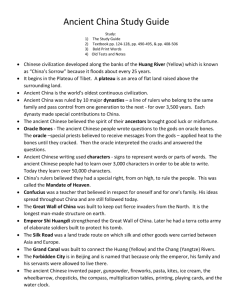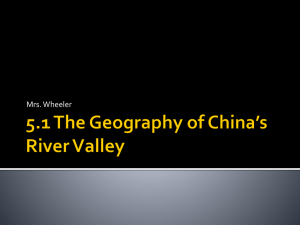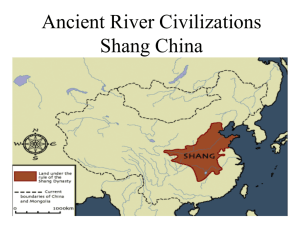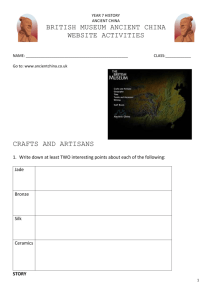Huang Ho - IHMC Public Cmaps (3)
advertisement
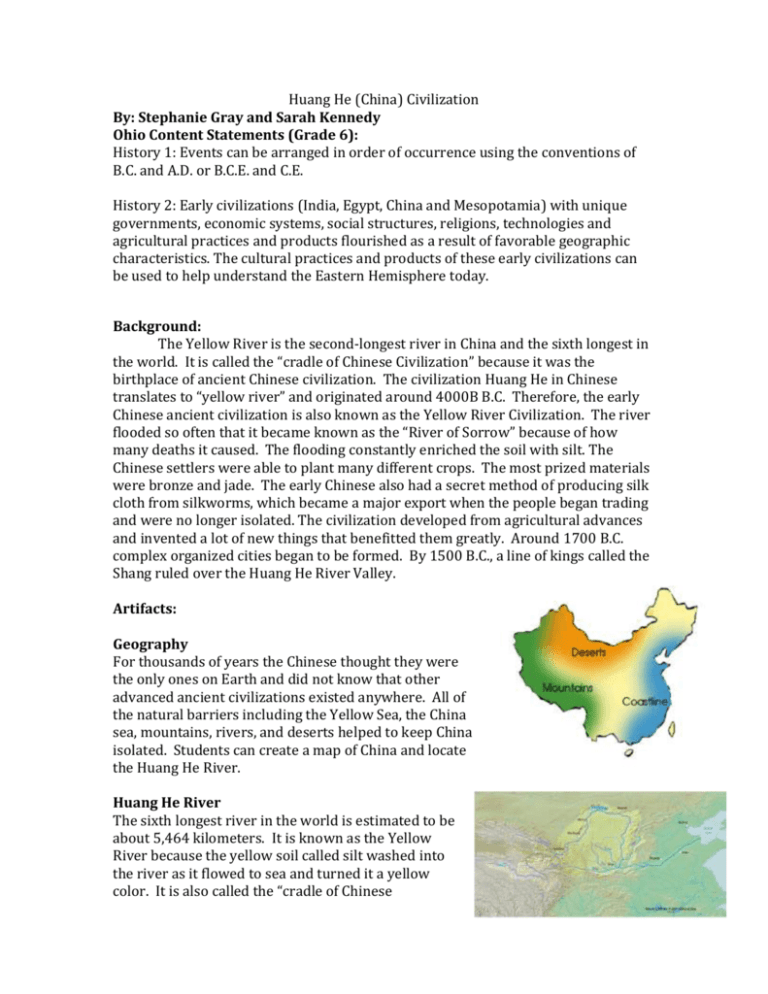
Huang He (China) Civilization By: Stephanie Gray and Sarah Kennedy Ohio Content Statements (Grade 6): History 1: Events can be arranged in order of occurrence using the conventions of B.C. and A.D. or B.C.E. and C.E. History 2: Early civilizations (India, Egypt, China and Mesopotamia) with unique governments, economic systems, social structures, religions, technologies and agricultural practices and products flourished as a result of favorable geographic characteristics. The cultural practices and products of these early civilizations can be used to help understand the Eastern Hemisphere today. Background: The Yellow River is the second-longest river in China and the sixth longest in the world. It is called the “cradle of Chinese Civilization” because it was the birthplace of ancient Chinese civilization. The civilization Huang He in Chinese translates to “yellow river” and originated around 4000B B.C. Therefore, the early Chinese ancient civilization is also known as the Yellow River Civilization. The river flooded so often that it became known as the “River of Sorrow” because of how many deaths it caused. The flooding constantly enriched the soil with silt. The Chinese settlers were able to plant many different crops. The most prized materials were bronze and jade. The early Chinese also had a secret method of producing silk cloth from silkworms, which became a major export when the people began trading and were no longer isolated. The civilization developed from agricultural advances and invented a lot of new things that benefitted them greatly. Around 1700 B.C. complex organized cities began to be formed. By 1500 B.C., a line of kings called the Shang ruled over the Huang He River Valley. Artifacts: Geography For thousands of years the Chinese thought they were the only ones on Earth and did not know that other advanced ancient civilizations existed anywhere. All of the natural barriers including the Yellow Sea, the China sea, mountains, rivers, and deserts helped to keep China isolated. Students can create a map of China and locate the Huang He River. Huang He River The sixth longest river in the world is estimated to be about 5,464 kilometers. It is known as the Yellow River because the yellow soil called silt washed into the river as it flowed to sea and turned it a yellow color. It is also called the “cradle of Chinese Civilization” because it was the birthplace of civilization, especially the Wei Valley and was the most prosperous region in early Chinese History. It was extremely prone to flooding and some of the floods that took place before the advent of modern dams, were some of the deadliest natural disasters ever recorded. The ancient Chinese farmed the fertile soil along the Huang He, using the river to irrigate their farms. Through a jigsaw approach, classmates can teach one another about significant crops that were made possible because of the fertile soil along the river. Writing There was a lack of written language for a significant time period in the Yellow River Civilization and did not develop until the Shang Dynasty. The invention of writing has been attributed to Ts’ang who was a minister in the court of the Yellow Emperor. This communication tool was used for divinity purposes to communicate between heaven and earth. It was used as a way for the elite to justify their rule and to keep records. Earliest writing was inscribed on oracle bones (bones or tortoise shells). Scholars have been able to piece together many details of the Shang civilization through oracle bones. They have confirmed the names of its kings, its style of government, its military history, its religious beliefs and rituals, and its society. The Chinese were the first people to make paper as we know it today. They made paper from rags. Then the Chinese learned how to print paper books. People in Europe did not begin printing paper books until hundreds of years later. Chinese writing is made up of logograms, where symbols represent meanings or words. Students can create their own “oracle bones” to practice writing Chinese symbols. They can work together to compare and contrast the Chinese and English languages. Social Structure Chinese history is marked by three successive dynasties that became the roots of Chinese culture and civilization: Xia Dynasty (2200-1776 BCE), the Shang Dynasty (17661122 BCE), and the Zhou Dynasty (1122-256 BC). The king in each dynasty divided the kingdom into different territories where aristocratic warlords ruled. The king had the power to add or remove new leaders when he thought necessary. The ancient people believed in supernatural forces and that the king could talk to the gods and receive help when needed. Students can create a multiple tier timeline to understand the timing of the development of the three dynasties compared to the development of other ancient civilizations. The class can be divided into three groups to represent the three ancient dynasties and can research the largest contributions and inventions of each one. Bronze The Shang and Zhou dynasties ushered China into the height of the Bronze Age. The bronze wares were unique national treasures for China in ancient times for their impressive designs, classical decorative ornamentation, and wealth of inscriptions. Ancient Chinese bronze was used to create ritual vessels used by aristocrats in ceremonies, weapons, and other miscellaneous objects. The possession of bronze wares was regarded as a status symbol. Students can work in partner groups to locate pictures of Ancient Chinese bronze wares on the web to hold a classroom “art show” to pay tribute to the artistic talents of this ancient civilization. Pottery Although pottery has been popular throughout the entire world’s history, pottery was actually invented in China around 7900 B.C. Vast amounts of pottery have been discovered in China at the Yellow River. These pieces included both practical items (bowls and plates) as well as decorative items (figurines). Ancient Chinese pottery was not fired. Instead, they were molded and then put in the sun to dry. For that reason, the pottery was not very durable and mostly small broken pieces of early Chinese exist today. Students could compare and contrast photographs of pottery from various ancient Chinese dynasties. They could look for similarities and qualities that help identify the piece of pottery’s origin. Silk In order to keep the economy thriving, the Huang River Valley society learned how to weave and make fine clothes. Eventually, they learned how to create silk. The rulers wanted to keep the methods of making silk a secret. However, citizens of the Huang River Valley did choose to trade their silk on the Silk Road. The Silk Road was a trade route that brought cultural immersion and agricultural growth. Students could brainstorm reasons behind why the rulers wanted to keep silk-making methods a secret. Students could also be given a map of the area and trace the Silk Road path. Mandate of Heaven War between the Shang and the Chou resulted in the mandate of heaven. Rulers created this mandate of heaven to convince the people that they had the right to rule. The mandate of heaven is based on four main principals. 1. The right to rule is established by Heaven. 2. There is only one heaven so there can only be one ruler. 3. The right to rule is based on the virtue of the ruler. 4. The right to rule is not restricted to one dynasty. Students could have a mock debate between the new rulers and the people. The rulers would have to try to convince the people that they are the ones who have the right to rule based on the mandate of heaven. Rice The Huang River Valley provided rich soil that was great for agriculture. The farmers grew many crops such as: rice, millet, wheat, green onions, ginger, grapes, peaches, plums, and wild chestnuts. In the dryer areas, farmers also herded animals. Although the Huang Ho River was usually an asset to citizens, its flooding was very dangerous. Citizens build levees to help hold back the water. Students could have a cultural cuisine day where people bring in foods from different cultures for students to try. Students could then discuss reasons why certain cuisines are native to certain areas. Masculine Power Gender roles have always played a big role throughout ancient Chinese history. The father always arranges the marriages for the daughters. Also, the father controls the amount of education and career for his children. The women in the family take on a subordinate position. All rituals are performed by the male family members. Students could use a Venn diagram to compare and contrast the differences in gender roles in today’s society versus the ancient Chinese society. Resources: Ancient china for kids: Mandate of heaven . (n.d.). Retrieved from http://china.mrdonn.org/mandateofheaven.html Cultural China. (2010). Ancient chinese bronze. Retrieved from http://arts.culturalchina.com/en/30Arts2225.html Livermore, R. (2009, September 21). The invention of pottery in china. Retrieved from http://suite101.com/article/the-invention-of-pottery-in-chinaa151306 Lo, L. (2012). Origins of writing systems. Retrieved from http://www.ancientscripts.com/ws_origins.html Metropolitan Museum of Art. (2012). Shang and zhou dynasties: The bronze age of china. Retrieved from http://www.metmuseum.org/toah/hd/shzh/hd_shzh.htm Mrdonn.org. (2012). Ancient china. Retrieved from http://china.mrdonn.org/lessonplans.html The indus and huang river valleys. (n.d.). Retrieved from http://indus_and_haung_rv.webs.com/huangrivervalleyeconomy.htm
